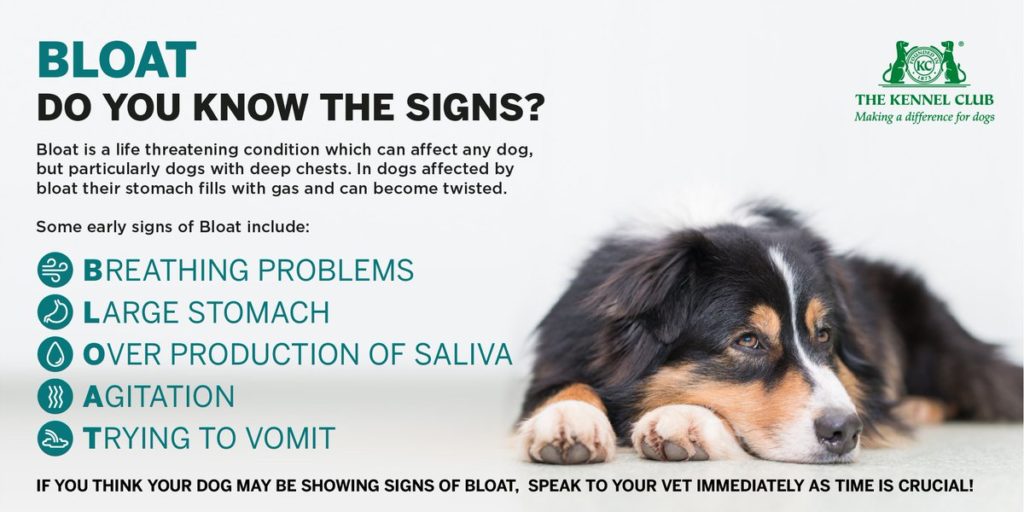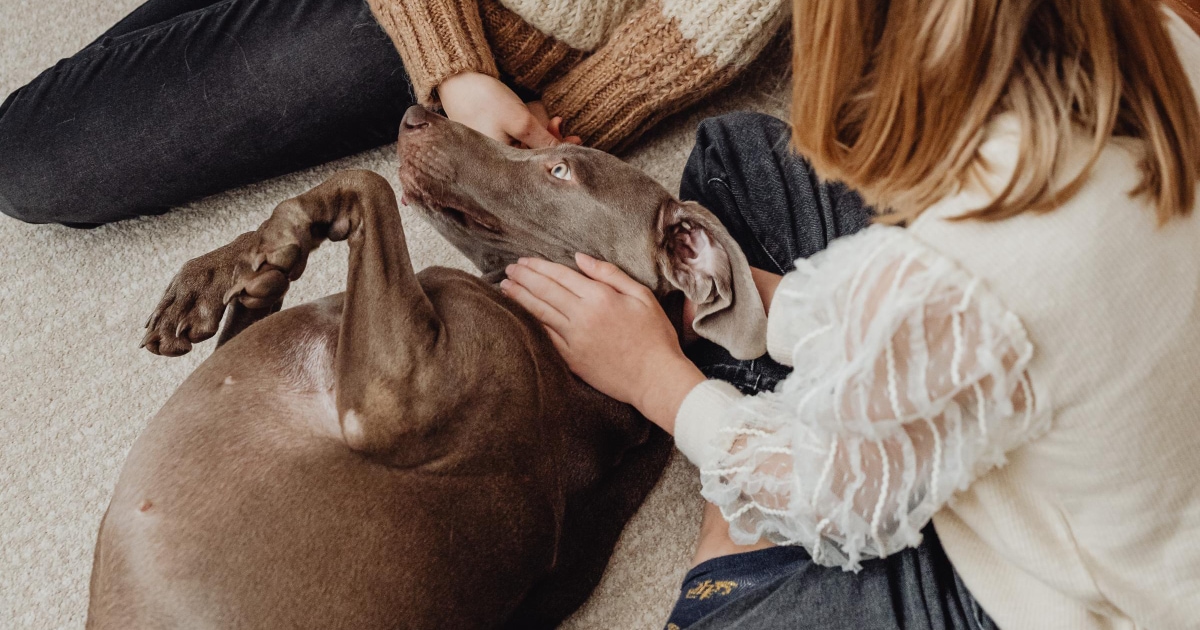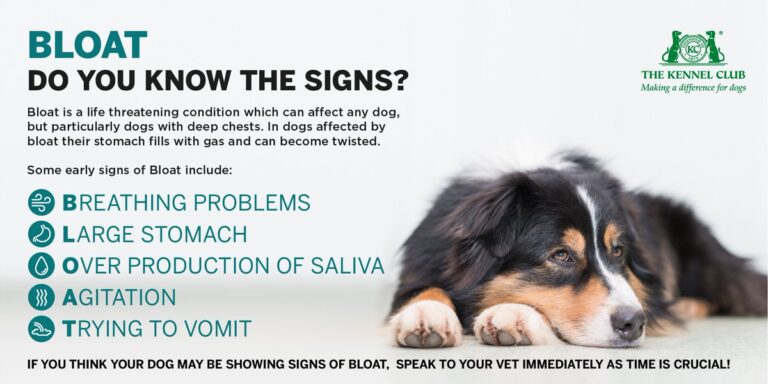Bloat can kill a dog within 24 hours due to the rapid progression of the condition. Bloat, scientifically known as gastric dilatation-volvulus (GDV), is a life-threatening condition that can affect dogs, particularly those with deep chests, like Great Danes and Boxers.
It is caused by the accumulation of gas in the stomach, which can lead to the stomach twisting on itself. This can result in a blocked blood flow and tissue death, leading to severe health complications or even death if left untreated.
The condition can progress rapidly and within 24 hours, a dog’s health can deteriorate significantly. Recognizing the early signs of bloat, such as restlessness, unproductive vomiting, and a distended abdomen, is crucial for timely intervention. Immediate veterinary care is essential to increase the chances of survival for dogs affected by bloat.

Credit: www.dogsfirst.ie
Understanding Canine Bloat
Canine bloat can be deadly, but the timeframe in which it can kill a dog varies. This condition requires immediate veterinary attention, and the delay in treatment can impact the outcome.
What Is Canine Bloat?
Canine bloat, also known as gastric dilatation-volvulus (GDV), is a life-threatening condition that commonly affects large and deep-chested dog breeds. It occurs when the stomach fills with gas or fluid, causing it to expand rapidly. As the stomach expands, it may rotate or twist, cutting off blood supply to vital organs and causing severe complications. Without prompt medical intervention, bloat can lead to a dog’s death within hours.
Causes Of Canine Bloat
There is no single cause of canine bloat, but several factors can contribute to its development. Some of the most commonly recognized causes include:
- Excessive eating or drinking: Consuming large quantities of food or water too quickly can lead to bloat, as the stomach becomes quickly distended.
- Heavy exercise right after a meal: Intense physical activity immediately after eating can increase the risk of bloat.
- Stress or anxiety: Dogs experiencing stress or anxiety may be more prone to developing bloat.
- Anatomical factors: Certain breeds, such as Great Danes, Doberman Pinschers, and Irish Setters, have a higher susceptibility to bloat due to their deep chests and narrow waists.
- Genetics: Bloat may have a hereditary component, as dogs with a family history of the condition are more likely to develop it.
Bloat is a complex condition with various contributing factors, and it can occur suddenly, even in seemingly healthy dogs. Recognizing the signs and seeking immediate veterinary assistance is crucial for increasing the chances of a positive outcome. Always consult with your veterinarian for guidance on preventing and managing canine bloat in your pet.

Credit: toegrips.com
Recognizing The Symptoms
Bloat, or gastric dilatation-volvulus (GDV) as it is medically known, is a serious and potentially life-threatening condition that can affect dogs of all breeds and sizes. The sooner you recognize the symptoms, the faster you can take action and potentially save your furry friend’s life. In this section, we will explore the physical and behavioral indications of bloat, enabling you to spot the warning signs as quickly as possible.
Physical Indications Of Bloat
Bloat often presents with several physical symptoms that can help you identify the condition. Keep an eye out for the following:
- Abdominal Distention: One of the most apparent signs of bloat is a visibly swollen or distended abdomen. If your dog’s belly appears unusually bloated or tight, it could be a sign of trouble.
- Unproductive Retching: Dogs experiencing bloat may attempt to vomit or retch, but nothing comes out. This is because the stomach has twisted, obstructing the normal flow of food and gases.
- Excessive Drooling: Excessive drooling, often accompanied by foamy saliva, can be indicative of bloat. This is a result of the stomach distress and discomfort your dog is experiencing.
- Restlessness and Discomfort: Dogs with bloat are often restless and unable to get comfortable. They may pace, whine, or exhibit signs of distress, such as panting and trembling.
- Rapid Heartbeat: An accelerated heart rate, accompanied by irregular heartbeat rhythms, can be a sign of bloat. If you notice your dog’s heart pounding unusually fast, it is crucial to seek veterinary care immediately.
Behavioral Signs Of Bloat
In addition to the physical symptoms, there are certain behavioral changes that may point to the presence of bloat:
- Anxiety and Agitation: Dogs experiencing bloat may exhibit increased anxiety and agitation. They may appear restless, unable to settle down, and may seek constant attention or reassurance from their owners.
- Weakness and Lethargy: As bloat progresses, your dog may become weak, lethargic, and unwilling to engage in their normal activities. This could be due to the pain and discomfort associated with the condition.
- Uncharacteristic Social Withdrawal: Some dogs with bloat may become unusually withdrawn or unresponsive. They may isolate themselves and avoid interaction with family members or other pets.
- Unusual Posture: Dogs with bloat may assume an unusual posture. They may stand or sit in a hunched-over position, reluctant to lie down, as lying flat can exacerbate the discomfort caused by the twisted stomach.
- Excessive Licking or Pawing: Another behavioral sign of bloat is excessive licking or pawing at the abdomen. This behavior is an instinctual response to alleviate the discomfort caused by the distended stomach.
Remember, early detection plays a vital role in increasing your dog’s chances of survival. If you notice any of these physical or behavioral indications, it is crucial to consult a veterinarian immediately. Time is of the essence when it comes to treating bloat, as the condition can progress rapidly and should never be taken lightly.
The Urgency Of Treatment
When it comes to bloat, time is of the essence. The urgency of treatment cannot be stressed enough. Bloat in dogs is a life-threatening condition that requires immediate medical attention. Delaying treatment can lead to severe complications and even death. In this article, we will explore the crucial timeframe to save a dog with bloat and discuss emergency treatment options to help you act swiftly in case your furry friend experiences this distressing condition.
The Timeframe To Save A Dog With Bloat
The moment you suspect your dog may be suffering from bloat, it is crucial to act swiftly. Time is of the essence, as the condition can rapidly progress and become life-threatening. Generally, you have a narrow timeframe of 1 to 3 hours to save your dog’s life.
Emergency Treatment Options
When it comes to bloat, immediate medical intervention is essential. Here are the emergency treatment options that can help save your dog’s life:
- Contact Your Veterinarian: Reach out to your veterinarian immediately to inform them of the situation. They will guide you on the next steps and may ask you to rush your dog to the clinic.
- Transportation: If your dog is unable to walk or is in severe distress, transportation is crucial. Use a secure and comfortable method of transport to safely move your dog to the veterinary clinic.
- Stabilization: At the clinic, the veterinarian will stabilize your dog’s condition. This may involve administering intravenous fluids, relieving pressure from the stomach, and addressing any complications that may have arisen.
- Diagnostic Tests: To accurately diagnose bloat and rule out other potential conditions, your veterinarian may recommend diagnostic tests such as X-rays or ultrasounds.
- Surgery: In severe cases of bloat, emergency surgery may be required. This procedure aims to untwist the stomach and secure it in its proper position to prevent further complications.
- Post-Surgical Care: After surgery, your dog will require attentive post-operative care, which may include pain management, monitoring, and a carefully tailored recovery plan.
The key to successful treatment is acting promptly and seeking professional help without delay. Remember, time is of the essence, and your swift actions can make a significant difference in saving your dog from the grasp of bloat.
Credit: opensea.io
Frequently Asked Questions Of How Long Does Bloat Take To Kill A Dog
How Long Can A Dog Live With Bloat?
Bloat in dogs can be life-threatening. Immediate medical attention is crucial. The survival rate after surgery is around 70-80%, but it varies depending on how quickly the condition is treated. Early detection and prompt treatment are vital for a dog’s chances of living through bloat.
How Long Does It Take For A Dog To Pass Away With Bloat?
A dog with bloat can pass away within hours. It is a life-threatening condition that requires immediate veterinary attention.
What Is The Timeline Of Bloat In Dogs?
The timeline of bloat in dogs can vary, but it usually progresses rapidly. It starts with discomfort, restlessness, and a distended abdomen. As it worsens, the dog may exhibit signs of distress, such as drooling, retching, or unsuccessfully trying to vomit.
Seeking immediate veterinary attention is crucial to address this life-threatening condition.
How Long Until Bloat Is Fatal?
Bloat can be fatal if left untreated. Timing varies depending on the severity and individual circumstances. Seek immediate veterinary care if your dog shows symptoms such as restlessness, abdominal pain, vomiting, or a swollen belly. Early detection and prompt treatment are crucial for a better outcome.
Conclusion
From the devastating consequences of bloat in dogs, one thing is clear – time is of the essence. Rapidly progressing, this condition can be fatal within hours. Recognizing the symptoms and seeking immediate veterinary attention are crucial. Remember, prevention is always better than cure.
By understanding the risk factors and taking preventive measures, such as feeding smaller meals and avoiding vigorous exercise after eating, we can protect our beloved furry friends. Keeping a watchful eye and acting swiftly could save a dog’s life. Stay informed, stay vigilant.



